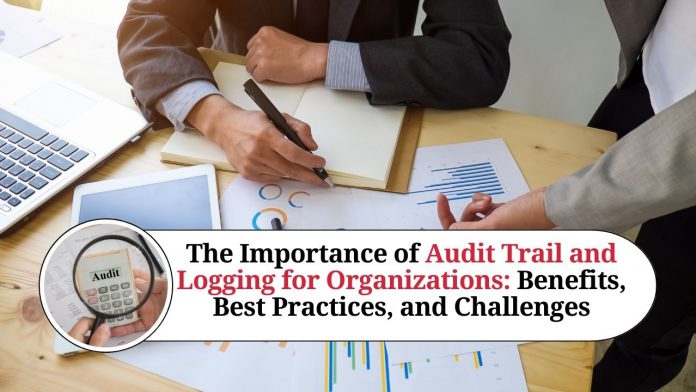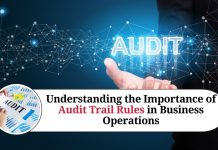In today’s digital age, it’s more important than ever to maintain a clear audit trail and logging system. Both of these functions play a critical role in ensuring that businesses and organizations can trace the path of their activities and transactions, which is essential for accountability, security, and compliance purposes. In this blog, we will explore the purpose of audit trails and logging, and how they can help organizations stay on top of their operations.
I. What is an audit trail?
An audit trail is a record of all activities and transactions that occur within an organization’s systems and processes. It provides a detailed and chronological history of events, including who performed the action, what they did, when they did it, and why. Audit trails can cover a wide range of areas, from financial transactions and inventory management to data access and security.
II. Why are audit trails important?
There are several reasons why maintaining an audit trail is crucial for businesses and organizations. Here are some of the most important ones:
- Compliance: Many industries, such as healthcare and finance, have strict regulatory requirements that require companies to keep an audit trail. This helps to ensure that organizations are adhering to the rules and regulations that govern their operations.
- Accountability: Audit trails promote accountability by providing a detailed record of who did what, when, and why. This can help organizations identify where things went wrong and who is responsible for errors or breaches.
- Security: Audit trails are essential for maintaining the security of an organization’s systems and data. They allow companies to track who accessed certain information or performed certain actions, which can help detect unauthorized access or malicious activity.
- Continuous improvement: Audit trails can also be used to identify areas for improvement in an organization’s operations. By analyzing the data in the audit trail, companies can identify bottlenecks, inefficiencies, and other issues that need to be addressed.
III. What is logging?
Logging is a process of capturing and storing events or data about the operation of an application or system. These events can include error messages, performance metrics, user activity, and more. Logging is often used for troubleshooting, debugging, and performance optimization.
IV. Why is logging important?
Logging is a critical component of any application or system because it provides valuable information that can be used to diagnose and fix issues. Here are some of the key benefits of logging:
- Troubleshooting: When something goes wrong with an application or system, logging can help developers diagnose the issue by providing a detailed history of events leading up to the problem.
- Performance optimization: Logging can also be used to identify areas where an application or system is experiencing performance issues. By analyzing the data in the logs, developers can identify bottlenecks and optimize performance.
- Security: Logging is an important tool for maintaining the security of an application or system. By logging user activity, developers can detect suspicious behavior and potential security breaches.
- Compliance: Similar to audit trails, logging can also help organizations meet regulatory compliance requirements by providing a record of system activity.
V. Best Practices for Audit Trails and Logging
To maximize the benefits of audit trails and logging, organizations should follow best practices to ensure the data collected is accurate, complete, and secure. Here are some of the key best practices:
- Define clear policies and procedures: Organizations should establish clear policies and procedures for collecting and storing audit trail and logging data. This should include defining what data should be collected, how it should be collected, and who is responsible for collecting and maintaining it.
- Collect all relevant data: Audit trails and logging should be comprehensive and include all relevant data. This includes data on user activity, system activity, and any events that may impact the security or compliance of the organization.
- Use secure storage: Audit trail and logging data should be stored in a secure manner to prevent unauthorized access or tampering. This can include encrypting the data, using secure storage solutions, and restricting access to authorized personnel.
- Regularly review and analyze data: Organizations should regularly review and analyze the data collected in audit trails and logging to identify areas for improvement, potential security breaches, and compliance issues.
- Automate where possible: Automating the collection of audit trail and logging data can help ensure accuracy and completeness while reducing the workload on personnel.
VI. Challenges of Audit Trails and Logging
While audit trails and logging systems are essential for modern organizations, they can also present certain challenges. Here are some of the key challenges:
- Data overload: Collecting and storing large amounts of data can be overwhelming, and analyzing this data can be time-consuming and complex.
- Resource-intensive: Implementing and maintaining audit trail and logging systems can require significant resources, including personnel, hardware, and software.
- Security risks: Storing sensitive data in audit trails and logging systems can present security risks if the data is not properly protected. Cybercriminals may target these systems to gain unauthorized access to sensitive data.
- Compliance requirements: Compliance requirements can vary by industry and jurisdiction, and organizations may need to meet multiple regulations, which can be challenging to manage.
VII. Overcoming Challenges
To overcome these challenges, organizations can take several steps:
- Prioritize data: Organizations should prioritize the data they collect, focusing on data that is essential for compliance, security, and accountability.
- Invest in automation: Automating the collection and analysis of audit trail and logging data can help reduce the workload on personnel while ensuring accuracy and completeness.
- Implement security measures: Organizations should implement security measures to protect audit trail and logging data, including encrypting the data and restricting access to authorized personnel.
- Stay informed about compliance requirements: Organizations should stay informed about compliance requirements in their industry and jurisdiction and take steps to meet these requirements.
VIII. Conclusion
In conclusion, audit trails and logging systems are essential for modern organizations. They provide critical data that can be used to ensure compliance, promote accountability, and identify areas for improvement. While these systems can present certain challenges, organizations can overcome these challenges by prioritizing data, investing in automation, implementing security measures, and staying informed about compliance requirements. By doing so, organizations can maximize the benefits of audit trails and logging and protect themselves against potential risks and threats.
Read more useful content:
- How to Save Tax on Salary
- Guide to Understanding Direct Taxes in India
- Filing Income Tax Returns
- GST E-invoice




















